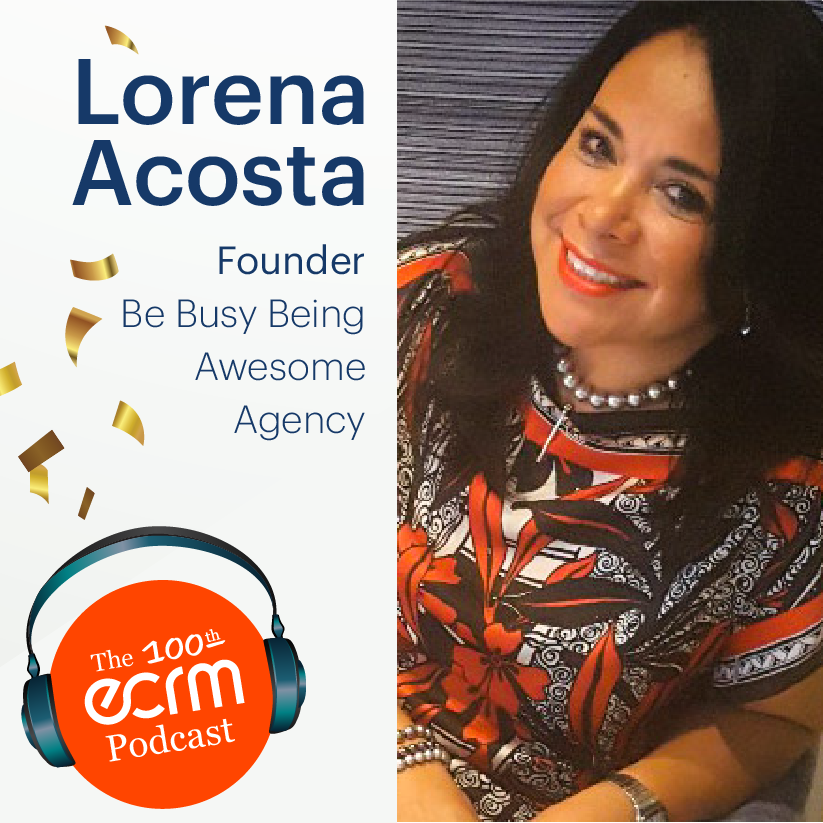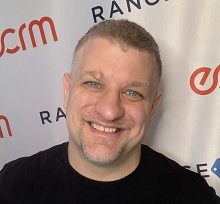Sales Without Selling: The Importance of a Strong Personal Brand 10/5/2020
 Regardless of what product or service you sell, or what category you manage, we all still do business with people, and so the trust our connections have in us is a key factor in our success. And one way to build, maintain and expand a trusting following as well as create meaningful, lasting relationships, is by developing a strong personal brand.
Regardless of what product or service you sell, or what category you manage, we all still do business with people, and so the trust our connections have in us is a key factor in our success. And one way to build, maintain and expand a trusting following as well as create meaningful, lasting relationships, is by developing a strong personal brand.
To celebrate ECRM’s 100th podcast episode, I spoke with someone who is an expert in developing such personal brands: Lorena Acosta, Founder of Be Busy Being Awesome Agency, who coaches executives and entrepreneurs on how to build trust and effectively engage their audience – and thereby drive sales growth – via personal brand development and social media engagement. Having just surpassed 1 million followers on LinkedIn, she definitely knows a thing or two about how to develop a personal brand on this platform, which incidentally, is the single greatest source of all of her business’ leads.
So what is personal branding, exactly? It’s the actions you take and the content you produce that helps you stand out from the noise, that showcases your knowledge, your skills, your capabilities, and develops trust with your audience by aligning your values and beliefs with theirs. In short, it’s your reputation in the outside world.
What it isn’t – is product marketing. Indeed, according to Acosta, personal branding should come first before products. “It’s people who are signing contracts with you, so they are the ones you need to earn trust from,” she says. “You can’t just focus on the product; it has to be the people who are your target.”
Authenticity is at the heart of personal branding. According to Acosta, when you are authentic, you are showing your true self, the way you are in the actual offline world (even though offline these days is for the most part video conferencing).
LISTEN TO THE PODCAST (WATCH THE VIDEO BELOW)
Your brand has to match in both worlds and any inconsistency between your online persona and offline persona will damage the trust you are trying to build – for example, if you are a gregarious showboat in your social media posts, but quiet and timid in-person. The conflict between the two results in people not knowing what they are going to get when they interact with you.
When you do build this trust through authenticity, though, people know what they can consistently expect from you, and that they can rely on you do deliver what you say you are going to deliver, time after time.
Being authentic may not come easy to some people. It means opening up about your values and beliefs and sharing some of your personal self with a broad audience. But you know the old saying: People do busines with people they like. And that typically means people who have similar values and beliefs. And the only way they can learn what you stand for is by putting your values and beliefs out there in the content you share. In doing this regularly, over time you will develop a segment of followers with similar values, referred to as tribes.
Tribes
A tribe, according to marketing guru Seth Godin, who wrote a book on the topic, is any group of people, large or small, who are connected to one another, a leader, and an idea. “Everything is through tribes,” says Acosta. “Who is in your tribe? Who is the leader of your tribe? Who are their followers and what kind of content are they sharing?”
You can be a part of several tribes at the same time. For example, my audience consists of several, each developed by the different type of content I post. There is the retail/CPG tribe that follows the posts that I create about the industry. Then there is my content tribe that’s interested in my posts about various aspects of content creation. I also post a lot about personal growth and enhancing productivity. That’s another group. Lately, I’ve been posting about the ins and outs of remote work, and another tribe has developed around that. And there is overlap between some of them. Many of the retail/CPG folks are now working remotely, so they fall into the group, too.
Getting started
Those beginning on a personal branding journey must start with an evaluation of your values, the image you want to create as a founder or executive (authenticity) and the types of tribe or tribes you with which you wish to engage.
These are the basis for the types of content you will create for social media. Above everything else, you should seek to deliver value with your content, and it should always be relevant to your audience. This is a sticking point for some people, who often confuse their audience with their industry. Oftentimes, content can be relevant to your audience even when it’s not necessarily relevant to your industry.
Case-in-point: One of ECRM’s team members posted a video asking viewers how they dress while working at home to get into “work mode.” As many people in our industry – particularly emerging brand-owners – work from home (even pre-COVID, when it was posted), the post generated thousands of views and about 100 comments. There were even people commenting on each others comments, and there was a great dialogue between them, as it was relevant to them on a personal level. It was a valuable topic that people wanted to discuss. And it was human.
“You have to humanize your brand,” says Acosta. “It’s up to each business owner to create content that’s compelling to their audience, that demonstrate that your personal brand, your character is aligned with their values. After you create your tribe then you can start with your content marketing and create an ecosystem, but you cannot start with your content marketing.”
Another element that is extremely important – and difficult to fake – is passion, that strong belief in what you are doing and an unbridled enthusiasm for delivering value, so that people really believe that you are in it to help them, versus just out to help yourself. When you come across as passionate, your audience will have the feeling that you are speaking with them, individually, rather than just shotgunning a marketing message out to the masses.
And when it comes to LinkedIn, or any social media platform for that matter, it’s important to no get too caught up in the numbers. More important than how many people follow you is how many of the right people are following you. Better to have 100 engaged followers who believe in you and what you are doing and will help spread the word, that a million followers who ignore you.
When you are able to build a tribe of enthusiastic followers, you’ll have a dedicated audience who will back you because they believe in you, regardless of what product or service you are selling. “I have never sold anything,” says Acosta. “I craft my messages in a certain way that pulls clients to my services without having to ask them.”
Racking up sales without having to actually sell anything. What could be better than that?
Editor's note: Those intersted in contacting Lorena: Click here to send her an email.

